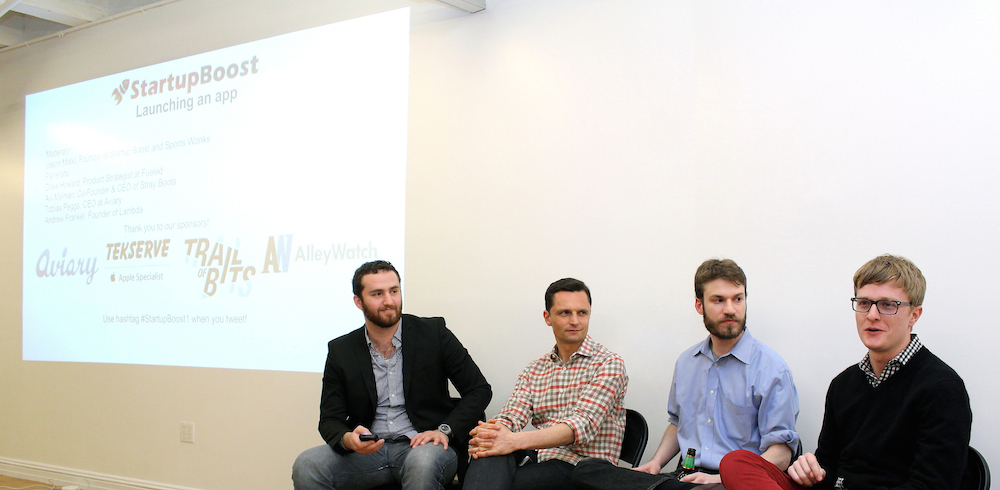Today, smartphones are a hot commodity. Millions of people worldwide have one, and everybody wants one. And what makes smartphones so much better than the cell phones of the past? Apps. The number of apps downloaded each year is in the billions, and so when entrepreneurs are looking to create the next big thing, building an app is one of the best ways to reach millions of consumers around the globe.
Of course, to build an app, a lot of work must be done and a lot of time must be spent. But there are a few key ideas that must be kept in mind when attempting such an undertaking and last week Startup Boost hosted Launching an App, with Startup Boost founder Jason Malki moderating a panel that included Drew Howard, Product Strategist at Fueled, a product design and development studio headquartered in NYC; Avi Millman, Co-Founder & CEO at Stray Boots, which offers real world games that make exploring a city fun, interactive, and engaging; Tobias Peggs, CEO of Aviary, a mobile photo editing platform; and Andrew Frankel, Founder at Lambda, a software consultancy that focuses on launching new startups.
According to the panelists, here are some of these key ideas that must be addressed when building an app:
Native App vs. Web Based App
There are advantages and disadvantages to each, and users tend to have different preferences depending on how they are seeking specific information, or a certain type of service. Native apps are applications accessed through icons on the device’s home screen and are installed through an application store such as Apple’s App Store or Google Play, while web apps are accessed through the web browser.. A major factor playing into the decision of a user to access the native app versus the web app is the frequency in which the user will be accessing your content. If a user is only visiting your content every once in awhile, than the web based app is sufficient. There is no need to download the app when it won’t be used often enough. But if a user finds themselves visiting your application time and time again, it is worth it to download the native app for easy access, rather than taking the extra steps every time to open the browser, put in the web address, etc.
iOS vs. Android
Should you build your app for both mobile platforms? If so, which one first? If not, which one should you choose to go with? Each one requires different steps in the process; each one has a different community, etc. Opinions vary on which is preferred and which to shy away from. Drew Howard, Product strategist at Fueled, prefers marketing to the iPhone users. “Generally, iPhone first is the way to go,” he said. “The user base on the iPhone is big enough for you to succeed or fail.” Conversely, Tobias Peggs, CEO of Aviary, states the exact opposite. He argues that the time consuming process of pushing the app through Apple is an issue. “We go Android first,” Peggs explains. “On Android, you can get a new version and can push it to Google Play today.” Millions of potential consumers can be found on either platform, and it seems it’s just a matter of opinion on which is the better way to go.
Paid vs. Freemium
Another matter for debate is whether to have an app available for purchased, or offer it for free. Among the consumer base, it is starting to become common knowledge that paid apps generally provide you with a better experience and a better quality product than do freemium apps. Although, a free app may be your best chance at drawing in customers and getting downloads. Peggs explains how the top free iPhone app downloads vastly outnumbers the top paid app downloads on a daily basis. “The broad consumer base is very attracted to free apps.” The consumer has come to expect a certain amount of in app purchases and banner ads for the app provider to generate revenue for the company, but still expects a quality product, regardless of the fact that it was free. The huge gap between the numbers of downloads for the top free apps and the top paid apps says it all. More people are downloading free apps.
Marketing and Discoverability
Marketing your product and actually getting consumers to download your app is a challenge in itself. There are so many apps out there and you want yours to stand out over all the others. This is where SEO (search engine optimization) and ASO (app store optimization) come into play. Most users are just browsing the top 10 lists, looking for interesting apps to download there. If you’re not in the top 10 lists, how do you get noticed? Having a unique name that is simple and easy to spell definitely helps. You don’t want the name of your app to be identical to 20 other apps or it will just get lost amongst the others. You also want to get your name to spread by word of mouth. If you have created a great product and people are enjoying it, they will tell their friends about it, who will in turn tell their friends and so on and so forth. If consumers like it enough, they will spread the word themselves. You simply need to plant the seed and watch the plant grow.
Creating, modifying and launching your own app is a long process that will require you to make some of the decisions listed above. You can find success or failure, regardless of whether your app is free or paid, particular to one mobile platform or the other, or native or web based. The bottom line is, if you have an awesome product, you will find success. Create a product that people want, and care about the customer. The rest will all fall into place.
Image credit: CC by Peshean Zhang





